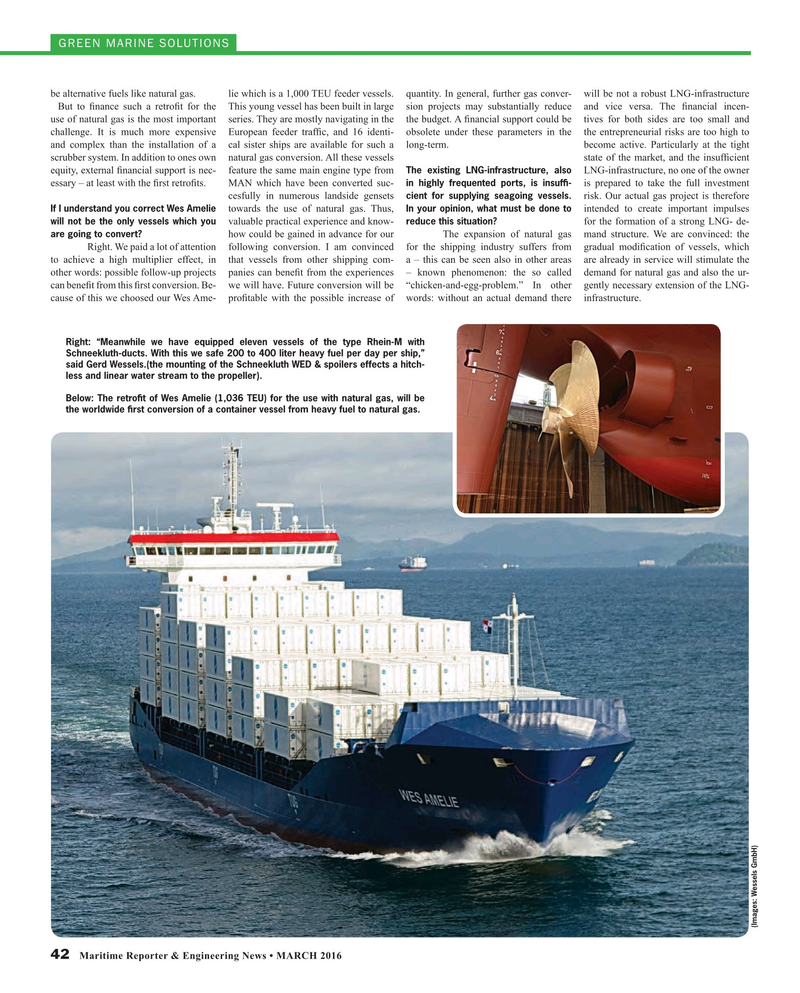
Page 42: of Maritime Reporter Magazine (March 2016)
Green Marine Technology
Read this page in Pdf, Flash or Html5 edition of March 2016 Maritime Reporter Magazine
GREEN MARINE SOLUTIONS be alternative fuels like natural gas. lie which is a 1,000 TEU feeder vessels. quantity. In general, further gas conver- will be not a robust LNG-infrastructure
But to ? nance such a retro? t for the This young vessel has been built in large sion projects may substantially reduce and vice versa. The ? nancial incen- use of natural gas is the most important series. They are mostly navigating in the the budget. A ? nancial support could be tives for both sides are too small and challenge. It is much more expensive European feeder traf? c, and 16 identi- obsolete under these parameters in the the entrepreneurial risks are too high to and complex than the installation of a cal sister ships are available for such a long-term. become active. Particularly at the tight scrubber system. In addition to ones own natural gas conversion. All these vessels state of the market, and the insuf? cient equity, external ? nancial support is nec- feature the same main engine type from LNG-infrastructure, no one of the owner
The existing LNG-infrastructure, also essary – at least with the ? rst retro? ts. MAN which have been converted suc- is prepared to take the full investment in highly frequented ports, is insuf? - cesfully in numerous landside gensets risk. Our actual gas project is therefore cient for supplying seagoing vessels.
If I understand you correct Wes Amelie In your opinion, what must be done to towards the use of natural gas. Thus, intended to create important impulses valuable practical experience and know- for the formation of a strong LNG- de- will not be the only vessels which you reduce this situation?
how could be gained in advance for our The expansion of natural gas mand structure. We are convinced: the are going to convert?
Right. We paid a lot of attention following conversion. I am convinced for the shipping industry suffers from gradual modi? cation of vessels, which to achieve a high multiplier effect, in that vessels from other shipping com- a – this can be seen also in other areas are already in service will stimulate the other words: possible follow-up projects panies can bene? t from the experiences – known phenomenon: the so called demand for natural gas and also the ur- can bene? t from this ? rst conversion. Be- we will have. Future conversion will be “chicken-and-egg-problem.” In other gently necessary extension of the LNG- cause of this we choosed our Wes Ame- pro? table with the possible increase of words: without an actual demand there infrastructure.
Right: “Meanwhile we have equipped eleven vessels of the type Rhein-M with
Schneekluth-ducts. With this we safe 200 to 400 liter heavy fuel per day per ship,” said Gerd Wessels.(the mounting of the Schneekluth WED & spoilers effects a hitch- less and linear water stream to the propeller).
Below: The retro? t of Wes Amelie (1,036 TEU) for the use with natural gas, will be the worldwide ? rst conversion of a container vessel from heavy fuel to natural gas.
(Images: Wessels GmbH) 42 Maritime Reporter & Engineering News • MARCH 2016
MR #3 (40-51).indd 42 3/3/2016 9:37:40 AM

 41
41

 43
43
